#16th c. germany
Text
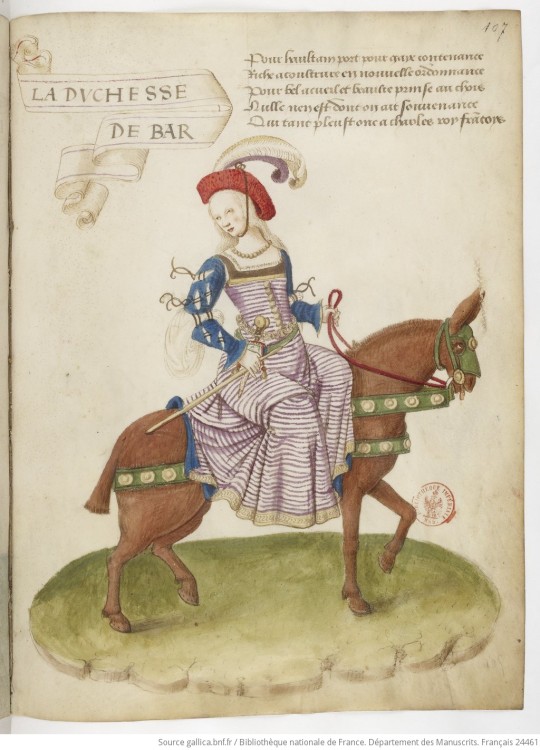


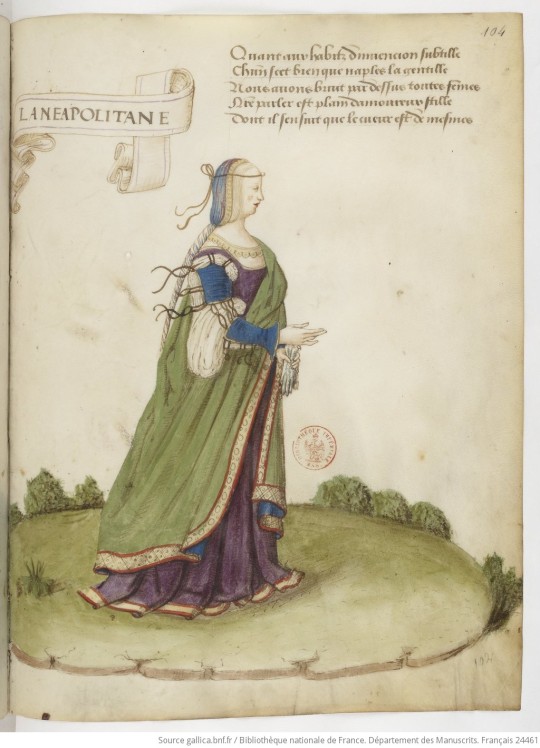


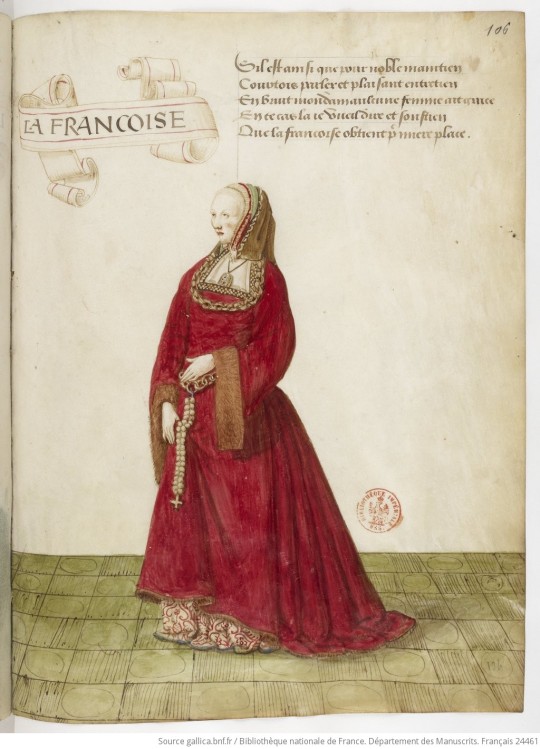


Collection of drawings accompanied by texts, known as Recueil Robertet, 1490-1520 France;
The Duchess of Bar
Women from Lombardy and Venice
Women from Naples and Florence
Women from Germany and France
Green and Yellow; White and Blue
#late 15th century#early 16th century#renaissance#manuscript#illuminated manuscript#illustrated manuscript#16th century#15th century#mdp16th c.#mdp15th c.#France#15th c. France#16th c. France#italy#costume illustration#illustration#15th c. italy#16th c. Italy#costume book#German Style#Germany#15th c. Germany#16th c. Germany#horseback#riding
121 notes
·
View notes
Text
Another Post About Crowley's Terrible Handwriting
Actually his handwriting here isn't terrible, it's just, like Anathema's spelling, 300 years too late.
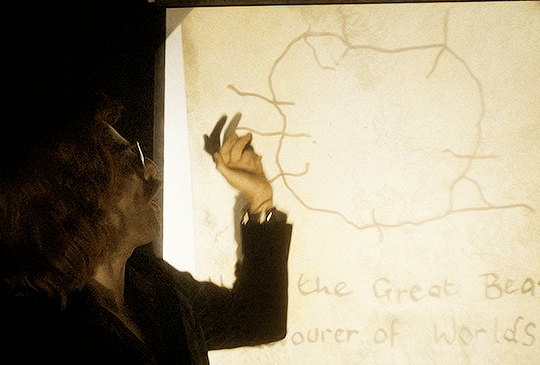
So first, I posit that we can be reasonably confident this is Crowley's handwriting because he is very likely the only celestial being besides Aziraphale who can spell devourer correctly.
Crowley has taken more care than usual with his penmanship today because this is a Fancy Presentation, and there are some delightful things to note about it:
--The beautiful serifs on each letter and variation in width of the strokes (the lowercase r's especially)
--Enthusiastic but intermittent capitalization of nouns
--The L that ends "Hail" is a small capital like the ones used in the Bible to spell LORD; the l in Worlds is lower-case
--The lozenge shape of the letter o
--Both s-es are oversized and dip below the writing line
--The kerning is terrible, the script wanders off the writing line at several points, and the location of the writing line is not imagined consistently
I am not an expert in the history of handwriting, but every single point of this suggests to me that Crowley learned to write in English in the late 16th or early 17th century, between say 1570 and 1620, and he learned to do it by copying printed material, not somebody else's handwriting. And it looks like late 16th-century writing. Or rather, like somebody learned to write by copying late 16th-century print and hasn't practiced enough for his style to change significantly in the last 400-500 years.
This means Crowley would have learned using a quill pen, poor devil, and if that's true no wonder he doesn't do it more often. (I wonder if this is why he now owns a pen that looks like it can break the sound barrier; if the Bentley is a permanent replacement for the loathsome, buttocks-abusing horse, maybe he keeps the expensive pen as self-reassurance that he'll never have to write with a quill again.) Quill pens would explain the lozenge-shaped o's: quills can only make a downstroke, so writers who used them shape o's as lozenges made of four downstrokes. Someone who learned writing with a quill would shape his o's like a calligrapher.
16th/early 17th century is the earliest I think Crowley would have learned to write in English because before that there was no block print; there was no print at all, only handwritten scripts of varying legibility, none of which look remotely like Crowley's handwriting does.
Here's what print looked like in Germany in 1471 (printing does not arrive in England for another 5 years after this):
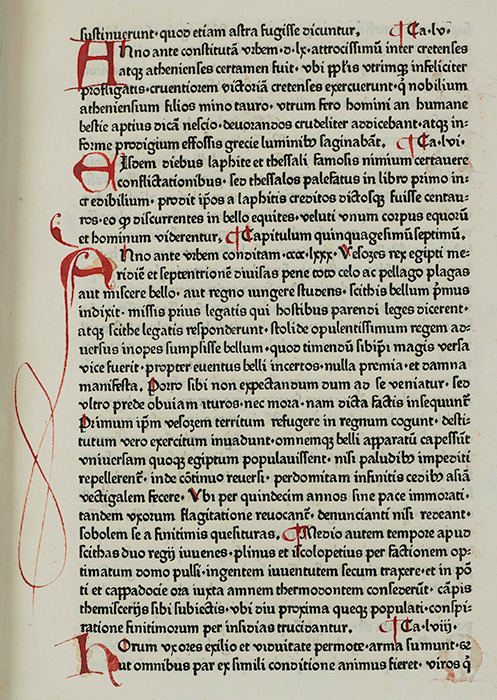
The printing press showed up in England in 1476. Between 1500 and 1600, England got its shit sorted out wrt fonts and typesetting and started turning out what we would recognize today as readable material.
Here's what English printing looked like in 1623, c. 150 years after the German one above:
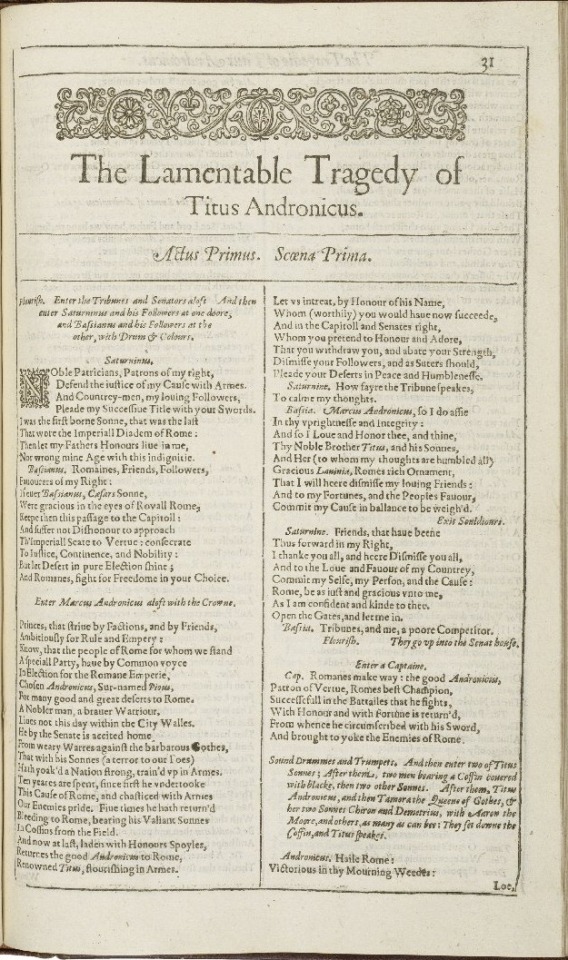
Not bad, right? I've received Xerox copies less legible than this in classes I paid for. I think it is likely based on his handwriting that Crowley learned to write from printed material a decade or two older than this. The adornments Crowley puts on his letters are serifs, not ligatures: these are not letters that were ever meant to join up in cursive, but letters that were copied from typeset.
From the 16th through the mid-19th century, variations in how a handwriter capitalized letters were very common, and two of these variations show up in Crowley's writing as well.
First, English inherited from German the capitalization of all its nouns. You can see it in Titus Andronicus, above (1623). Due to variations in education and taste, this quickly shifted to capitalization of whichever nouns the writer (or publisher, or printer) felt were important to capitalize, as you can see in Paradise Lost from 1688, below. Hail the Great Beast, devourer of Worlds.
Second, It was also very common during this time to capitalize terminal letters of words, either as a sign to the reader that previous letters had been omitted or because writers using quill pens wanted to be sure readers knew what letter they were looking at through the smudges and weird spacing and general wretchedness of the reading experience imposed by quill writing. I think this latter reason may be why Crowley writes "HaiL" when his other letter L, in "Worlds," is both lowercase and carefully printed with a pretty serif.
Handwriters in English between 1500 and 1800 also had a major hard-on for abusing the letter s, which was shaped like a lowercase f (to contemporary eyes) or a loose S, either of which drop below the writing line. Here's an example in print from 1688:

Use of the long S in print fell out of favor and disappeared abruptly in the UK after 1800.
Crowley's S-es could be a holdover from this: they both drop below the writing line, and they're both oversized.
What I think we can say for sure is that he's not very good at writing s-es, so they always turn out bigger than he intends. The S in "Beast" is noticeably different at the left curve than the S in "Worlds," which I would expect for someone who hasn't written thousands of s-es yet, and the S in "Worlds" looks very much like someone has faithfully rendered a shape they have seen rather than written a letter. Since he can write a letter r elegantly but can't do a curved s, it suggests to me that he hasn't had as much practice doing the curved s yet as he has the other letters, which fits with someone used to writing a long s 75% of the time.
Even the kerning speaks to me of someone who learned to write with a quill: leaving (comparatively) large spaces between letters gives the ink somewhere to drip and smudge without rendering the letter illegible.
There's one other reason I think Crowley probably learned to write in English in the 16th century: He's lazy, and he probably wouldn't have needed to know before then.
The movable-type press arrived in England in 1476. The Protestant Reformation kicked off in England c. 60 years later in 1534 when Henry VIII declared himself head of the English Church. Prior to the surge in literacy among the wealthy and merchant classes in the 16th century, thanks to this intersection of printing press and Protestants (who believe it's important that each person read the Bible for themselves), almost no one knew how to read, including most of the gentry and nobility, and still fewer knew how to write. If you had a message, you sent a guy or you showed up yourself. If you had something you wanted recorded, you summoned a scribe. If you needed to know something, you found somebody who knew and you asked them.
By the time of Queen Elizabeth's accession in 1558, 82 years after William Caxton began operating England's first movable-type printing press, a fully literate royal court were passing each other and their spies and their assassins gossipy notes like everybody was a 12yo in math class. Elizabeth wrote letters and poems. Among the gentry gentlewomen replaced monks as the medical caregivers for their communities (bc Henry shut down all the monasteries), and they wrote and shared and copied multi-generational "receipt books" and herbals of medical and cosmetic treatments. In the space of a single generation, literacy--the ability to write, not just to read--became a prerequisite for functioning in the upper echelons of society.
So if he didn't already know by then, Crowley would have needed to learn to write in English in the mid-16th century. And he would have had to learn it with a quill. (Wearing black probably came in handy for all the ink he spilled or dripped on himself.)
Last to consider is the W in "Worlds," which has no serifs and is not written with any particular attempt at straightness or symmetry. To me this suggests that Crowley learned to write w's from a modern reference, not his original reference. And this makes perfect sense: w was very much in use in the 16th century in English, but nobody agreed on how to write or print it, so there were crossed v's, two capital U's, and this weird gothic lowercase n with extra tentacles. W, Crowley would have learned, always needs to be checked up on before you commit.
Crowley's spelling here is modern, which is frankly a huge achievement for someone who was present for the formation and transformation of all 3 English languages. The contemporary Modern English we use today was a going concern for over 2 centuries before anyone wrote an English dictionary, and it was three centuries before dictionaries became authorities on how to spell correctly and people started giving a shit about that. (Before that as long as people could read the word and understand what you meant by it in context, you'd spelt it correctly.)
Taken together, the W and the modern spelling suggest that although Crowley almost never writes by hand, he reads regularly. This matches with two Words of God I've seen from Neil Gaiman (which I am too lazy to find and link) in which he mentions that Crowley likes to read but won't admit to doing so or to liking books.
Aziraphale should get him a book about ducks for Valentine's Day.
65 notes
·
View notes
Text
TFATWS Anniversary Event
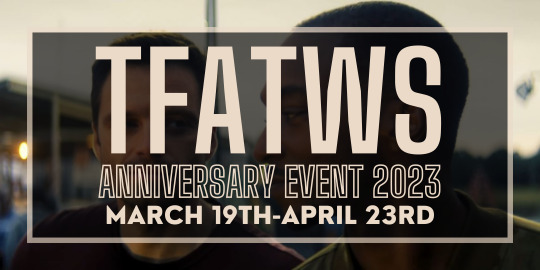
The @sambuckylibrary will be holding a The Falcon and the Winter Soldier Anniversary Event! The event will start on March 19th and run until April 23rd. During that time, we will be reblogging and sharing the work you guys create here on our blog.
You can post fanfiction, art, moodboards, edits, podfics, etc. It’ll be a low-stakes event. No need to sign up. Just remember to tag @sambuckylibary in your post for each fill, and we will be tracking #tfatwsanniversaryevent2023 for reblogs.
If you are posting on AO3, please add it to TFATWS Anniversary Event 2023 Collection.
Each week will have a different theme with prompts from Monday to Friday. Each prompt will also come with a badge you may use for it when you post. The weekly themes and their prompts will be:

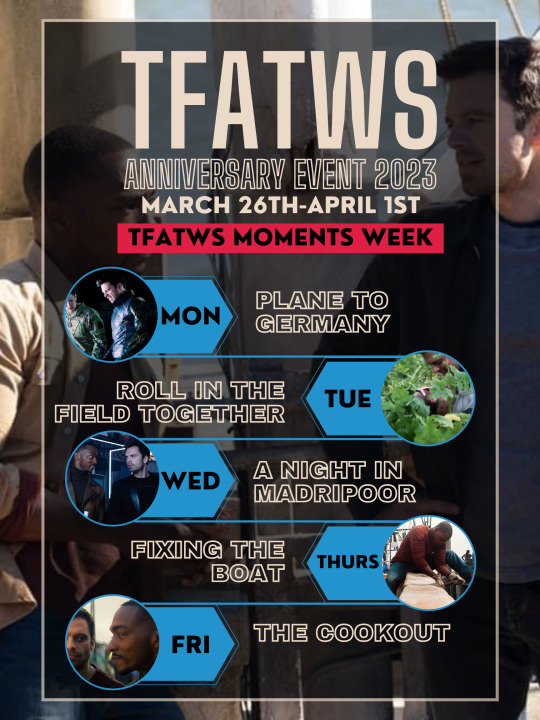
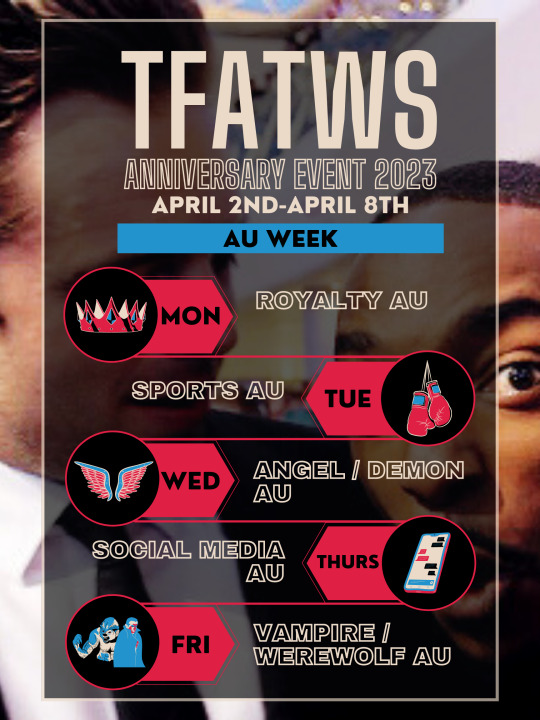


For the text version of the information above as well as the FAQ and rules, check the information under “keep reading”.
Pre-TFATWS Week: March 19th-March 25th
Monday: The Steering Wheel Incident
Tuesday: Searching for Bucky Barnes
Wednesday: On the Run Together
Thursday: In the Soul Stone
Friday: Six Months of Ghosting Sam
TFATWS Week: March 26th-April 1st
Monday: Plane to Germany
Tuesday: Rolling in the Field Together
Wednesday: A Night in Madripoor
Thursday: Fixing the Boat
Friday: The Cookout
AU Week: April 2nd - April 8th
Monday: Royalty AU
Tuesday: Sports AU
Wednesday: Angel/Demon AU
Thursday: Social Media AU
Friday: Vampire/Werewolf AU
Romance Tropes Week: April 9th - April 15th
Monday: Getting Together
Tuesday: Enemies to Lovers
Wednesday: Hurt/Comfort
Thursday: Fake Dating
Friday: First Time
SamBucky Week: April 16th - April 23th
Monday: Redwing
Tuesday: A Couple of Guys
Wednesday: I Would Be His Roommate, But
Thursday: Costco Tub of Lube
Friday: Best Friend's Best Friend
FAQ
What is this?
It’s a SamBucky event.
Is there any pressure?
No pressure at all. Fill one prompt. Fill all the prompts in a week. Do however many you please.
Can I fill more than one prompt with one piece of art/one fic?
Yes! You can fill one prompt with one piece of art or fic. You can try to fill all five prompts that week at once with one piece of art or fic. You can do any number in between.
Are there any prizes for making anything for this event?
Just the satisfaction that you made something cool.
Is it just SamBucky?
Yes please, just SamBucky. There can be side ships, but the main ship should be SamBucky.
How long will this event run?
It will run from March 19th and run until April 23th.
I heard there are badges I can use for each fill?
There are! They will be revealed on the Sunday of each week.
Rules and Guidelines
What are the guidelines for the bingo?
I will be borrowing some of this from the MYSU Valentine’s Day Bingo 2022 Guidelines, since they were fantastic.
For Everyone:
1. Remember to @sambuckylibrary in the post as well as #tfatwsanniversaryevent2023.
2. Please also tag the square you’re filling (for instance, if the square is “Sports AU”, use “#sports au” as one of your tags when posting about it on Tumblr).
3. If you’re uploading to AO3, please:
a ) Say somewhere which prompt you’re filling.
b ) Add it to TFATWS Anniversary Event 2023 Collection (TFATWS_Anniversary_Event_2023).
For Artists:
1. Create at least one piece of new art that can’t have been posted anywhere else before this.
2. All visual art forms are welcome:
a ) Gifsets, at least 3 gifs.
b ) Aesthetic boards or moodboards, at least 4 images each.
c ) Drawing/painting, that is not a sketch.
For Authors:
1. At least 500 words.
2. Posted on Tumblr or AO3.
3. Can be part of a series, but should work as a standalone.
For Podficcers:
1. The podfic should at least be 10 minutes long.
2. It should be posted on either Tumblr or AO3.
3. The podfic can be of a fic made for the event, a fic not made for the event while still adhering to the prompt, or a notfic.
Things to be mindful of when creating:
For Sam
Avoid framing Sam only as a caretaker or emotional support for Bucky. Be mindful of Sam acting angry or aggressive in an out-of-character way and falling into the angry/sassy Black man trope (check out the MCU source material to help with character traits).
Avoid decentering Sam as a main character and refrain from focusing entirely on Bucky.
In art: avoid whitewashing Sam’s skin and research drawing Black characters.
General disclaimer: Race affects every aspect of his life, including interacting with police/government and the white structures of the world when it comes to performing his duties as Cap and simply being a Black man that lives in the U.S.
For Bucky
Avoid phrasing “flesh/normal/human hand” to refer to the contrast between his prosthetic arm and his right arm. The phrasing is ableist. You can simply refer to his prosthesis when relevant, otherwise use “right/left arm/hand”.
Specific Tags:
Avoid tags in AO3 like “Sam Wilson is a Gift”, “Sam Wilson is a Saint”, and "Bucky Needs a Hug".
Have fun and we look forward to your TFATWS Anniversary fics!
- The Mods
#tfatwsanniversaryevent2023#sambucky#sam wilson#bucky barnes#tfatws#tfatws anniversary event#sambucky fanfic#sambucky art#sambucky edit#sambucky moodboard#mod: thatmexisaurusrex
169 notes
·
View notes
Text
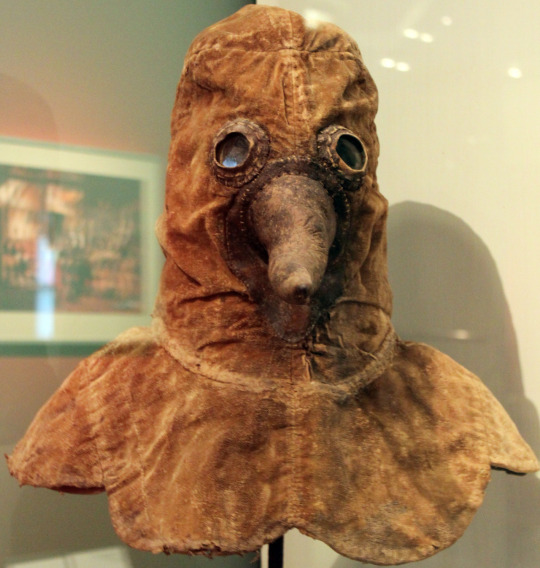
Plague doctor mask, Germany, c. 16th century. As protection against the disease doctors wore a leather gown with a wrap and a mask. Herbs or sponges soaked with vinegar were put into a beak-like protrusion in order to filter the air.
2 notes
·
View notes
Photo
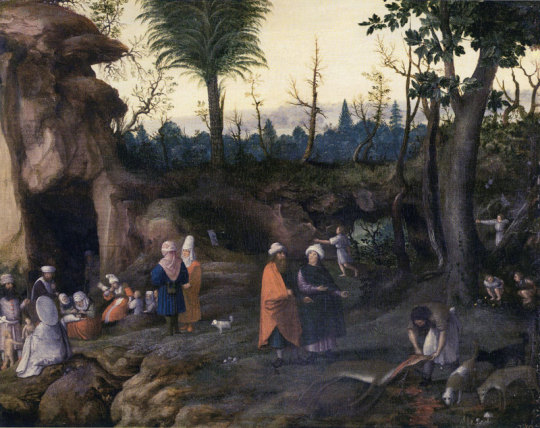
Cornelis van Dalem, Jan van Wechelen - Landscape with nomads -
oil on canvas, height: 29.5 cm (11.6 in); width: 35.5 cm (13.9 in)
The Staatliche Kunsthalle (State Art Gallery) is an art museum in Karlsruhe, Germany.
Cornelis van Dalem (1530/35 – 1573 or 1576) was a Flemish painter and draughtsman active in Antwerp in the middle of the 16th century and an important contributor to the development of landscape art in the Low Countries. Van Dalem introduced into landscape painting new themes, which he derived from his humanistic education, and searched for new ways of representing his themes.
Jan van Wechelen or Hans van Wechelen (c. 1530 – 1570) was a Flemish painter and draughtsman active in Antwerp in the middle of the 16th century known for his landscapes, biblical subjects and genre scenes.
Only a few works by Jan van Wechelen are known to exist as most of his oeuvre was destroyed by war and the Iconoclasm of the 16th century. The majority of these are landscapes and religious scenes. His oeuvre also includes a few genres scenes and an architectural painting of a church interior. The artist’s work enjoyed an excellent reputation at the beginning of the 17th century and was collected by Rubens as well as the prominent art collectors Cornelis van der Geest and Pieter Stevens.
Jan van Wechelen collaborated regularly with fellow Antwerp artist Cornelis van Dalem. Van Wechelen was a gifted staffage painter and his dignified figures are regarded as well suited to van Dalem’s landscapes. At least three such collaborations between the two artists are suspected. This includes a Landscape with nomads (also known as Landscape with gypsies at the Staatliche Kunsthalle Karlsruhe. This painting likely represents a family of gypsies as a seated woman wears the distinctive oval white hat which was a common indicator for a gypsy woman in 16th century Flemish paintings.
35 notes
·
View notes
Text

Royal Air Force Tactics During the Battle of Britain | Classic Warbirds
During the years preceding the Second World War (1939 - 1945), the prevalent idea that affected military thinking was, as Stanley Baldwin, leader of the Conservatives, stated in a speech in the House of Commons on the 10th November 1932 that “the bomber will always get through”, as it was envisioned that in a future war the enemy would deliver a knockout blow from the air. Limiting the damage enemy aircraft could do would be the responsibility of the Air Defence of Great Britain, which was established on the 1st January 1925, and was the component of the Royal Air Force tasked with defending the UK's airspace.
As the RAF expanded during the 1930s, on the 13th July 1936 the Air Defence of Great Britain was disbanded and replaced on the 14th July 1936 by three new commands, Bomber, Coastal and Fighter alongside Training Command, formed on the 1st May 1936. Fighter Command, with Air Chief Marshal Hugh Dowding as its Commander-in-Chief, was now responsible for the defence of the UK's airspace.
The tactics developed by Fighter Command, as part of its Air Fighting Manual, called for tight formations of three aircraft in a Vic formation to perform Fighter Area Attacks, of which there were six different scenarios to attack enemy aircraft, depending on the amount and type of aircraft intercepted. Once they spotted the hostile aircraft the squadron would position themselves according to the Fighter Area Attack chosen. However, this was based on the premise that attacking bombers would fly from airfields in Germany without effective fighter cover, which wouldn't be the case in the summer of 1940, as the Luftwaffe could operate from airfields in France.
Fighter Command Structure
When the battle began on the 10th July 1940, Fighter Command, whose headquarters were at Bentley Priory, was still commanded by Air Chief Marshal Hugh Dowding and was structured as follows:
No. 10 Group
Commanded by Air Vice-Marshal Sir C J Quintin Brand
Headquarters: RAF Box
Covering: South West England and South West Wales No. 11 Group
Commanded by Air Vice-Marshal Keith Park
Headquarters: RAF Uxbridge
Covering: South East England and London
No. 12 Group
Commanded by Air Vice-Marshal Trafford Leigh-Mallory
Headquarters: RAF Watnall
Covering: East Anglia, Midlands, Mid and North Wales No. 13 Group
Commanded by Air Vice-Marshal Richard Saul
Headquarters: RAF Newcastle
Covering: North England and Scotland
No. 14 Group
Commanded by Group Captain Philip F. Fullard (1)
Headquarters: Drumossie Hotel, Inverness
Covering: Scotland No. 9 Group (2)
Commanded by Air Vice-Marshal Wilfred McClaughry
Headquarters: RAF Barton Hall
Covering: Northern Ireland and North West England
1. Replaced by Air Vice-Marshal Malcolm Henderson on the 20th July 1940.
2. Formed on the 16th September 1940.
Aircraft Strength - 10th July 1940
Fighter Command had 656 fighters available, consisting of 29 Hawker Hurricane, 19 Supermarine Spitfire, 6 Bristol Blenheim and 2 Boulton Paul Defiant squadrons. It could also call on Nos. 804 and 808 Naval Air Squadrons, the former equipped with Gloster Sea Gladiators and the latter Fairey Fulmars, who were on loan from the Fleet Air Arm.
View the order of battle for Fighter Command on the 10th July 1940
The Luftwaffe could call on over 2,000 aircraft to begin their campaign to gain air supremacy over Southern England, one of the requirements for Operation Sealion the invasion of Britain to take place. Mainly comprising Messerschmitt Bf 109 and Bf 110 fighters, Heinkel He 111, Dornier Do 17 and Junkers Ju 88 twin-engined bombers and Junkers Ju 87 dive bombers.
Squadron Structure, Vic and Finger-Four Formation
During the battle, a typical Royal Air Force fighter squadron was to have twelve aircraft and pilots available for operations. The ideal number for the squadron was at least sixteen aircraft to cover those being serviced or out of action. To cover pilots who were on leave or unable to fly it was intended for the squadron to have at least 20 pilots to call upon, although at times some squadrons were unable to meet this number.
The squadron would be split into four sections (red, yellow, blue and green) with three pilots (one, two and three), with two sections making up one flight of aircraft. Each section, flying in Vic formation, was led by a section leader with two wingmen, with red and yellow normally making up 'A' flight and blue and green normally making up 'B' flight, with a colour and number identifying each aircraft. For example, as shown in the squadron structure diagram below, the red section leader would be known as red one.
Structure of a typical RAF squadron during the Battle of Britain
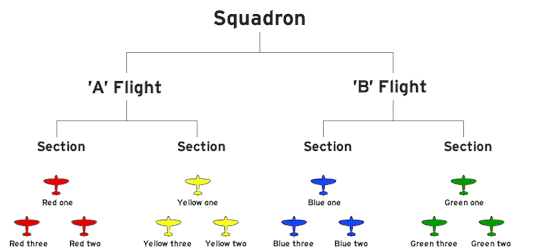
When the battle began, the Luftwaffe were able to operate from airfields in France, enabling their fighters to escort the bombers to Britain. So when the RAF and Luftwaffe met in the skies above Britain and the English Channel, the ineffectiveness of the Fighter Area Attack tactics and Vic formation was soon exposed. As with the required tight formation, only the lead aircraft of every Vic was able to search for enemy aircraft, as the other two aircraft in the Vic had to focus on keeping formation, so an attacking aircraft could catch the formation by surprise, particularly from the rear. Although the tactic was later modified so that the fourth section would fly 1,000ft above and behind the other three sections, whilst weaving, to help minimise the chances of an attack from the rear, casualty rates among these aircraft were high.
Typical RAF squadron formation during flight in the Battle of Britain
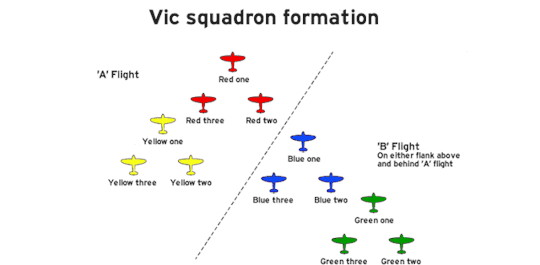
Despite complaints about the Vic formation, no official change was forthcoming, so some squadrons adapted a tactic being used by the Luftwaffe called Schwarm, which was a more flexible tactic. This had been developed after the combat experience of the Luftwaffe's Condor Legion in the Spanish Civil War (1936 – 1939) and would be called Finger-four by the RAF. This involved four aircraft flying in formation, but operating in pairs. This allowed the attacking aircraft to be covered by his wingman with the overall formation spaced at about 200 meters apart and flying at various altitudes. This meant the pilots could focus on looking for enemy aircraft and also protect each other, and if the formation was attacked the two pairs would split up, one going left the other to the right. The Finger-four tactic also meant that the squadron formation changed as it would now be divided into three sections of four as opposed to the Vic formation's four sections of three.
In the aftermath of the battle, Fighter Command modified its tactics in 1941, before, in 1942 the Finger-four formation was officially added to pilot training.
Finger-four squadron formation

Engaging the Luftwaffe
When an incoming raid had been plotted by Britain's Air Defence System, also known as the 'Dowding System' (see diagram below), squadrons would be scrambled by controllers as and when needed, as opposed to a large formation, allowing an enemy raid to be under constant harassment by the Royal Air Force which also had the effect of breaking up the Luftwaffe formations, however, fighter sweeps by the Luftwaffe were not a priority for Fighter Command.
Dowding System

The opening stages of the battle, during July and early August 1940, saw the Luftwaffe probe the Royal Air Force's defences by attacking shipping in the English Channel and targets along the coast. However, mid-August saw the Luftwaffe change tactics and launch Operation Eagle Attack on the 13th August 1940, known as Eagle Day, this saw the Luftwaffe try to lure the RAF into battle in the air by targeting Fighter Command's infrastructure.
Many tactical instructions were issued during the battle, and this new phase saw the first major tactical changes by Fighter Command when, on the 19th August 1940, Air Vice-Marshal Keith Park, Air Officer Commanding, No. 11 Group, Fighter Command, issued a number of instructions. Among these was for RAF fighters to operate only over land or gliding distance to the coast.
Despatch fighters to engage large enemy formations over land or within gliding distance of the coast. During the next two or three weeks, we cannot afford to lose pilots through forced landings in the sea.
And prioritising German bombers as targets.
Against mass attacks coming inland, despatch a minium number of squadrons to engage enemy fighters. Our main object is to engage enemy bombers.
Seven days later on the 26th August 1940, Air Vice-Marshal Keith Park issued further instructions to help with the interception of German formations, as not all squadrons sent to intercept were doing so. This would require details on the intercepted raid to be detailed over the radio to help controllers vector more squadrons to the correct area.
To enable Group and Sector Controllers to put all squadrons in contact with the enemy formation leaders are to report approximate strength of enemy bombers and fighters, their height, course and approximate position immediately on sighting the enemy.
One of the final major instructions issued by Air Vice-Marshal Keith Park was on the 11th September 1940 that when contact was made with the Luftwaffe formation, the Spitfires should tackle the fighter screen, whilst the Hurricanes concentrated on the bombers and close escort. However, as radar couldn't differentiate between the aircraft in a raid it wasn't always possible for this to happen.
READINESS SQUADRONS: Despatch in pairs to engage first wave of enemy, Spitfires against fighter screen, and Hurricanes against bombers and close escort.
By the time this instruction was issued, the Luftwaffe had again changed tactics and were targeting London and other cities across the UK, in what was to become known as the Blitz.
The Big Wing
The use of multiple squadrons for one large formation wasn't a completely new tactic for Fighter Command, as they had been used during Operation Dynamo (26th May 1940 - 4th June 1940) the evacuation from Dunkirk, France. The issue with these larger formations was if vectored to the wrong position, missing the enemy formation, there may not be any reserve squadrons available to intercept the raid instead. As the battle progressed the idea of large formations of multiple fighter squadrons intercepting enemy raids resurfaced, championed by Air Officer Commanding, No. 12 Group, Fighter Command, Air Vice-Marshal Trafford Leigh-Mallory and Acting Squadron Leader of No. 242 Squadron, Douglas Bader
The idea of the Big Wing was to get three to five squadrons (36 – 60 aircraft) to form together and engage enemy aircraft in numbers. Known as the Duxford Wing, it was used for the first time on the 7th September 1940 and was led by Acting Squadron Leader Bader. Comprised of Nos. 242 and 310 Squadrons, flying Hurricanes from RAF Duxford, and No. 19 Squadron, operating from Duxford's satellite airfield RAF Fowlmere, flying Spitfires, they formed together to protect RAF North Weald whilst its squadrons were in combat. They arrived to late to stop the airfield from being attacked but did engage the Luftwaffe and for the loss of one aircraft, claimed eleven German aircraft. This would be a familiar story, as due to the amount of time it took to get the aircraft into formation, it normally wasn't until after the target had been attacked that the Big Wing would make contact with the attacking aircraft.
One of the successes of the Big Wing was its psychological effect on Luftwaffe aircrews, who were told the Royal Air Force was close to being defeated, to then come up against a formation of up to 60 fighter aircraft.
Big Wing formation
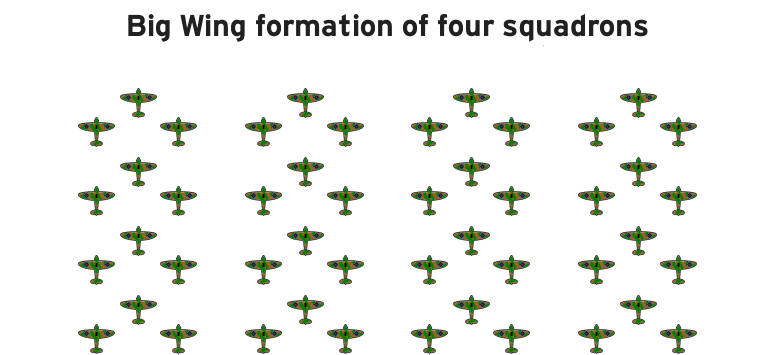
4 notes
·
View notes
Text

Bards don't hold lutes correctly in fantasy video games, probably because their developers don't hold guitars properly!


I'll let these renaissance gents from the string packages demonstrate older playing positions (I am not sure of the source of this print, but I can tell you it's from the 16th century and can guess it's from Germany, due to the haircuts).
Let's go older:

18th Dynasty Egypt, c. 1350 BC

Gandhara, 1st century AD

Parthia, c. 3rd century BC - 3rd century AD
I'm just pulling from Wikipedia, but other iconography fits along this range.
4 notes
·
View notes
Photo

Saint Stephen
1502-1508, (German, c. 1460-1531)
Tilman Riemenschneider
Germany, Würzburg, 16th century
Lindenwood with polychromy and gilding
#saint stephen#cma#sculpture#medival#gothic#I adore the melt between the medieval and modern finish of this piece
19 notes
·
View notes
Text
Deutschribing Germany: regions
Baden-Württemberg (Baden-Württemberg)

Baden-Württemberg is divided into thirty-five districts (Landkreise) and nine independent cities (Stadtkreise), both grouped into the four administrative districts (Regierungsbezirke) of Freiburg, Karlsruhe, Stuttgart, and Tübingen. The capital city is Stuttgart.
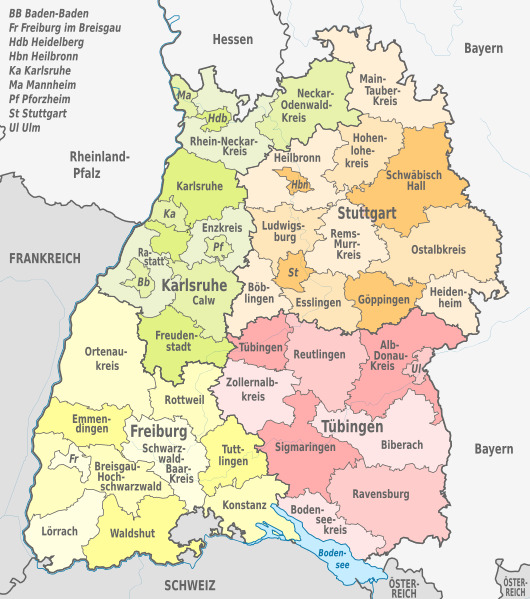
Climate
The predominant climate type is warm-summer humid continental, but the western part (Baden) has a subtropical highland climate. As a result, in most parts of Baden, the climate is warm almost all year round and summers are mostly dry, while winters are wet and foggy.
The rest of the state has more temperate temperatures, especially in summer. Areas of high elevation get snow frequently, and summers are rainier than in Baden.
Due to the climate differences, average annual temperatures range from 5 °C (41 °F) in the Black Forest to 13 °C (55 °F) in the subtropical areas.
Economy
Although Baden-Württemberg has relatively few natural resources compared to other German states, it is among the most prosperous and wealthiest regions in Europe.
The state is known for its strong industries, including car manufacturing, electrical engineering, and mechanical engineering. It hosts the headquarters of some of the largest German companies, such as Borsch, Mercedes-Benz Group, Porsche, and Schwarz Group (owner of Kaufland and Lidl).

Baden-Württemberg is also a popular holiday destination, including a variety of sights like the residential court towns of Ludwigsburg and Karlsruhe, the spas of Baden-Baden, the medieval architecture of Ulm, the Black Forest, and the traditional university towns of Heidelberg and Tübingen.

Famous people
Alena Gerber - model, actress, and TV host
Anja Jantschik - journalist and writer
Anne-Sophie Mutter - violinist
Ayla - producer and DJ
Frank Christoph Schnitzler - actor, artist, and musician
Frederik I - Holy Roman emperor
Friedrich Wilhelm Schnitzler - landowner, business manager, and politician
Jens Weidmann - economist
Sophie Weber - singer and younger sister of Mozart's wife Constanze
Walter Haeussermann - scientist
Gastronomy
There are two distinct regional cuisines: those of Baden and Swabia. The cuisine of Baden is considered one of the best regional cuisines in Germany and is based on fruit, herbs, vegetables, game, poultry, fish, smoked products, wine, and beer. It has many influences from Alsace and Switzerland. Specialties include Flammkuchen (pizza with thin crust) and Schäufele (pig's shoulder meat).
Swabian cuisine has a reputation for being rustic but rich and hearty. It is characterized by fresh egg pasta, soups, sausages, broths, and sauces. The most famous specialties are Maultaschen (meat and spinach-filled dumplings, either fried or served in broth) and pretzels.

Schäufele

Brezel
History
Baden-Württemberg was formed from the historical territories of Baden, Prussian Hohenzollern, and Württemberg.
100 - Roman invasion of Württemberg
3rd century - the Alemanni force the Romans to retreat west
496 - Frankish invasion
915-1313 - Duchy of Swabia
1083-1495 - County of Württemberg
1112-1803 - Margraviate of Baden
1278-1805 - Further Austria
1495-1803 - Duchy of Württemberg
1500-1808 - Swabian Circle
16th century - Protestant Reformation
1524-1525 - German Peasants' War
1618-1648 - Thirty Years War
1803-1806 - Electorate of Baden; Electorate of Württemberg
1805-1918 - Kingdom of Württemberg
1806-1918 - Grand Duchy of Baden
1918-1945 - Republic of Baden
1945-1946 - South Baden
1945-1952 - Württemberg-Baden
1945-1952 - Württemberg-Hohenzollern
1946-1952 - Baden
1951 - vote on the union of Baden and Württemberg
1952 - State of Baden-Württemberg
1956 - opponents of the merger sue and win
1970 - vote on the restoration of the state of Baden fails
Languages
Two dialect groups of German are spoken in Baden-Württemberg: Alemannic and Franconian dialects. These include East Franconian, High Alemannic, Low Alemannic, Rhine Franconian, South Franconian, and Swabian.
Monuments and landmarks

Baden-Baden

Maulbronn Monastery Complex
1 note
·
View note
Text


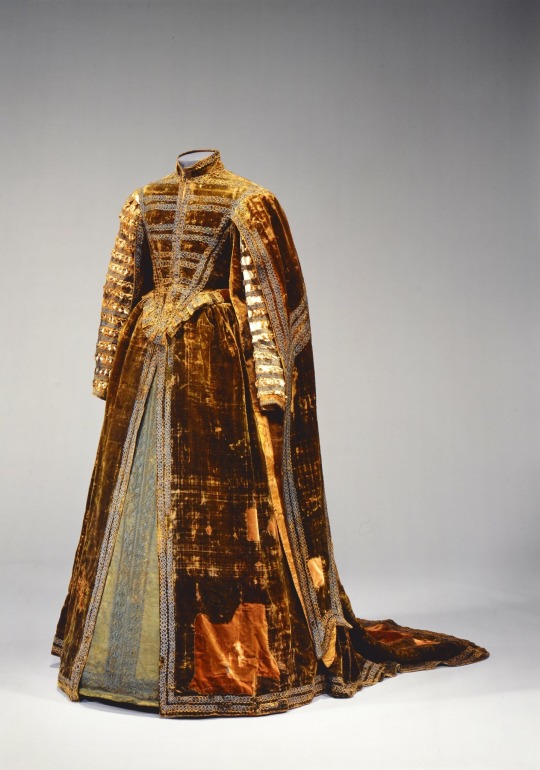
GOWN OF COUNTESS PALATINE DOROTHEA SABINA OF NEUBURG
South Germany, c. 1598
Silk, metal
From the burial place of the Counts Palatine of Neuburg in Lauingen.
Assigned from the parish church of St Martin in Lauingen on the Danube in 1877.
This magnificent dress is justifiably famous all over the world. It is one of the very few complete women's garments from the 16th century to have survived. It is made of olive green silk velvet with gold trim and has hanging sleeves with yellow, slashed atlas silk lining. The green taffeta underskirt is decorated with silver lace. The materials alone show that this garment was worn by a princess; other women were forbidden to wear such precious clothing. Dorothea Sabina of Palatinate-Neuburg died at the age of only 21 and was buried in this gown. The garment embodies the Spanish courtly fashion prevalent in Europe, albeit of an Italian cut that was popular in Bavaria.
Bavarian National Museum
17 notes
·
View notes
Text
tl;dr: the German government is currently doing tleverything in their power to brake the Paris agreement and further fuck up the climate.
Last year one of the biggest energy companies in Germany asked for permission to tear down a German village called Lützerath (roughly pronounced loo-tzer-rat) to access the coal stored in the ground beneeth it. (No one has been living there for a year or two now because RWE relocated them, but activists have occupied it ever since.) RWE presented evidence, that the coal would be needed to cover Germany's energy usage. The Green Party saw this request as an option to make a deal. In exchange for Lützerath RWE would have to stop mining coal in 2030 instead of 2038 (many climate activists and scientists agree that that would be way too late). RWE obviously accepted because they would be able to make a huge amount of money.
Now, with this information, this deal might seem reasonable. However, independent sources have shown that RWE made completely wrong claims. The coal under Lützerath is not necessary to cover Germany's energy needs, and moreover, this would mean that more CO2 would be released than with the original plan of stopping in 2038. This would also mean that Germany would inevitably brake the Paris agreement in which 194 countries agreed to limit global warming to 1.5°c and many more policies to help stop or at least slow down climate change.
Instead of seeing this new information, coming to the conclusion that they were given false information by RWE and not allow RWE to access the coal und Lützerath, they've decided to double down and go through with the plan. This includes the Green Party, which has built its entire political campaign and image on saving the environment and climate.
This triggered demonstrations all over the country and many more activists went to Lützerath. Apparently around 700 people were camping in Lützerath last week.
And once again, instead of seeing the uproar and accepting that they were lied to, the government made the decision to clear Lützerath by force. As of last Wednesday (11.01.2023) the police officially started clearing Lützerath.
Supply networks were set up and the activists stood their ground with many more trying to join. On Saturday there was a Demonstration with 35,000 participants (according to fff) and Greta Thunberg was present.
But as of now (noon, Monday 16th January) Lützerath has officially been cleared. The last two activists who were left in the Tunnels beneath Lützerath have given up (I don't blame them at all).
We all knew that this point would come but the hope was to slow down the process long enough that they couldn't start this year. That would have meant one more year for political campaigning and pressure und one year less in which the carbon from Lützerath gets released into the atmosphere.
I don't know whether all has failed yet. Activists are still fighting and demonstrations are still happening but it doesn't seem like the government cares. Not even the party that prides itself on its climate policies (although some fractions of the party have spoken out gheir support for the activists and distance themselves from the decision)
Logically i knew that politicians and the government care more about money and the economy than people but a part of me hoped that it wasn't all of them and seeing it so blatantly is still shocking.
I see a lot of praise of Germany on the English speaking side of the Internet and not a lot about the bad, which is obviously very present and important to talk about.
I don't really have a conclusion except, go demonstrate if you can and if you can't, there's other stuff you can do, like buying locally. If none of that is an option for you, don't feel to bad because the majority of pollution is cause by big companies and to stop them we need policies so go vote in all elections you can both national and local.
Although it sometimes feels like all is lost, that's only actually true if we do nothing.
2 notes
·
View notes
Text
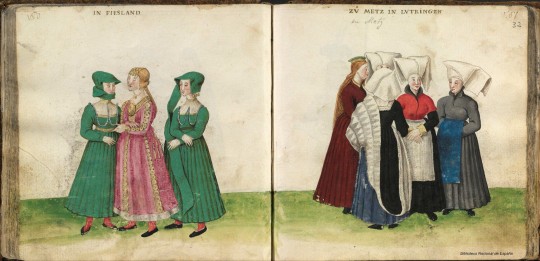

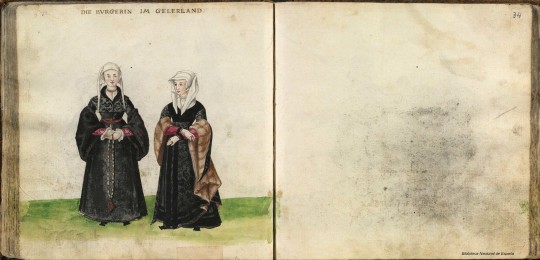
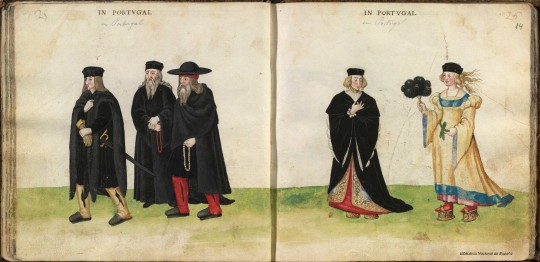
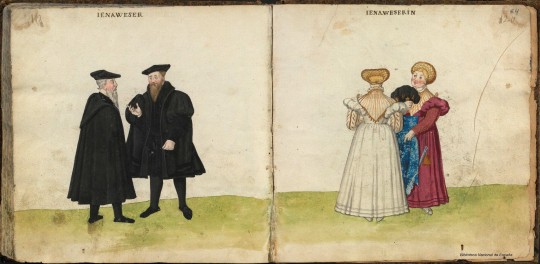
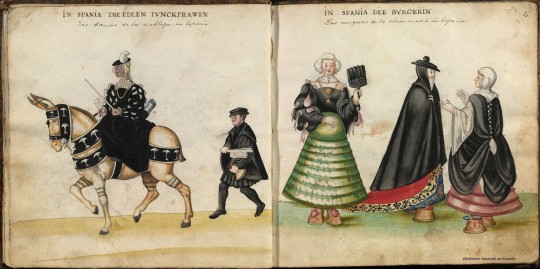

Códice de Trajes, costumes from the realms of Charles V, Holy Roman Emperor and King of Spain, made in Germany in mid 16th century (1540s-1550s)
Friesland and Metz
Netherlands and Gederland
Gelerland
Portugal
Genoa
Spain
Spanish dance
#costume illustration#16th century#mid 16th century#mdpillustration#spain#italy#netherlands#germany#portugal#manuscript#16th c. portugal#16th c. spain#16th c. germany#16th c. netherlands#16th c. italy#traditional dress#1540s#1550s
299 notes
·
View notes
Text
May 16th (Monday) we'll have a lunar eclipse in the early morning hours :3 here in Germany, we won't see much of it, but I thought, I'd share this info with you guys ^^ Maybe you'll have a better luck with this spectacle c:
8 notes
·
View notes
Text

Laocoön Group (c. first third of the 16th century)
Northern Italy, bronze, attributed to Amico Aspertini
Bode-Museum, Berlin (Germany), acquired in 1916
3 notes
·
View notes
Text

Regarding Anything Written on Tarot Symbolism Here
[Originally written and posted on blogspot Thursday, August 25, 2011]
There is nothing especially “mystical” about the origins of the Tarot, at least no more than Chess, or Lot Books, or allegorical artwork of the Middle Ages and Renaissance in general. I have never asserted otherwise. The late 18th-to-20th century speculations of the occultists on the origins of the Tarot are just that. They do not even qualify as Tradition or authentic folklore, any more than the most bizarre excesses of the 19th century Theosophical Society literature qualify as authentic Vedic or Hindu teachings.
The most substantial research into the actual history and development of the Tarot deck has been done by Michael Dummett, better known to the world as an analytical philosopher. Dummett has written that the various forms of early tarot packs developed since the 15th century range in number from 97 to 42 cards, but with reason to believe they sprung from a more-or-less standard model of the 78 card deck of which the Visconti-Sforza pack is a good example. While this may not have been the exact form of the deck initially, it quickly became the standard. This is the form of the 56 suit cards and 22 trump cards. The suit cards are divided into groups as batons, cups, swords, and coins. The court cards are divided according to type (baton, cup, sword, and coin) and rank (king, queen, knight, page).
The word “Tarot” likewise had no particularly mystical origins, being borrowed from the French “tarau”, which was in turn simply the French adaptation of the Italian “tarocco” (plural, “tarocci”). Throughout the 15th century, the Tarot was known simply as “carte da frionfi” which means nothing more than “cards with trumps.” The word “tarocchi” did not widely apply to the game until the 16th century. The word itself is of unknown origin, and a 16th century writer, Alberto Lollio refers to it as being “without an etymology.”
The names and symbols of the suits have varied over time. The spades, clubs, hearts, and diamonds of the familiar card decks were invented by French cardmakers circa 1470s, while the earliest reference to tarot cards comes from a Ferrarese court account book dating 1442. In Italy, Iberia, and most of France, the suit signs were the same as ordinarily used for the regular pack of cards. On Spanish cards, and those used in southern Italy, the appearance of the suit designs differ from other indigenous Italian cards, notably by the separate placement of swords and batons rather than intersected as in the Italian type. Dummett relates that until c.1750 tarot cards everywhere outside of Italy carried the suit signs of the Italian type, therefore an indication that Italy is where they were invented. The four court cards of each suit is also not an anomaly of the tarot. There are regular card decks from 15th century Germany that also include four court cards for each suit. Therefore the outstanding feature setting the tarot, or tarocchi decks apart from regular decks was the additional suit of trumps or “triumphs”.
There is no evidence of the Tarot being used for occult or fortune telling purposes until the 18th century. A 15th century Dominican preacher wrote a vehement condemnation of gambling and gaming, including a mention of tarot cards alongside dice and regular playing cards as instruments of gaming – surely if there were a widespread practice of using the tarot for “occult” purposes, it would have been mentioned and condemned. The Tarot therefore was invented to play specific types of card games, for which a substantial amount of literature exists.
If there is “esoteric” content to the Tarot, it is not automatically intentional in every respect, except insofar as symbolic and allegorical content common to the culture of the time served as the subject matter for the Trump cards. In which case it is as open to interpretation as any other allegorical or symbolic material from any other device of any other culture, as well as is the numerical structure of the deck itself.
The symbolic and allegorical subject matter of the Trump cards led Guenon to recognize the Tarot as a substantial example of vestigial survival of Traditional symbols in mainstream cultural artifacts. If one chooses to take the Traditionalist line of interpretation of the Tarot, as we do here, it should be along the lines outlined by Evola (The Mystery of the Grail, p.9-10), "The characteristic feature of the method that I call 'traditional' (in opposition to the profane, empirical, and critical-intellectual method of modern research), consists in emphasizing the universal character of a symbol or teaching, and in relating it to corresponding symbols found in other traditions, thus establishing the presence of something that is both superior and antecedent to each of these formulations, which are different from and yet equivalent to each other. Since anyone tradition may have given to a common meaning a more complete, typical, and transparent expression than have the others, seeking to establish correspondences is consequently one of the most fruitful ways to understand and integrate what in other cases is found in a more obscure or fragmentary form."
It is the actual pictorial content of the Tarot, its symbolism and allegories, numerical structures, and even its aristocratic origins that validate a Traditionalist line of interpretation (as well as other factors that will be apparent to anyone familiar with the literature), not the absurd latter-day 18th-20th century occultist fabrications regarding its origins in ancient Egypt or among Gypsies, or other fantastical nonsense. A perenialist or Traditionalist interpretation of the Tarot, along the methodical lines advocated by Evola, or the widely recognized Traditionalist art historian Coomaraswamy for example, is just as valid as the Traditionalist interpretation of any artifact, artistic or religious, of any culture.
JDS
0 notes
Text
Creating a timeline
Amanda Knox
November 2nd, 2007
Meredith Kercher (21 British Student) is found dead in the house in Perugia, Italy, that she shared with American student Amanda Knox.
Police say her body is partially clothed, with her throat cut.
November 6th, 2007
Knox and Raffaele Sollecito are detained for questioning.
Knox allegedly confesses to being at her home when Kercher was killed and implicates Patrick Lumumba (the owner of a bar where she worked).
Lumumba also is detained.
November 19th 2007
Police name Rudy Hermann Guede as fourth suspect and arrest him the following day in Mainz, Germany.
November 20th, 2007
Lumumba is released after two weeks in prison when his alibi is corroborated.
He later sued Knox for libel, winning 40,000 euros ($54,000) in damages.
November 22nd, 2007
The text of a note Knox wrote on November 6, while in police custody, is published by CNN and other media outlets. Knox addresses an alleged confession, saying: “In regards to this ‘confession’ that I made last night, I want to make clear that I’m very doubtful of the verity of my statements because they were made under the pressures of stress, shock and extreme exhaustion. Not only was I told I would be arrested and put in jail for 30 years, but I was also hit in the head when I didn’t remember a fact correctly.”
December, 2007
Rudy Hermann Guede is arrested. His fingerprints were found at the murder scene. A vaginal swab taken from Kercher matches DNA from Guede. Guede admits to police that he had sexual relations with Kercher but says another man killed her while he was in the bathroom.
July 11th, 2008
Italian prosecutors formally charge Knox, Guede and Sollecito with murder.
September 6th, 2008
Rudy Guede asks for a separate fast-track trial, fearing that Knox and Sollecito had formed a pact against him. His defense attorney says, “In recent weeks a lot of poison has been spread by the defense teams, and we feel the necessity to find some form of serenity in a separate hearing.”
October 28th, 2008
Knox and Sollecito are indicted on murder charges.
Guede is found guilty of murder in his fast-track trial and sentenced to 30 years. (The sentence is reduced to 16 years on appeal in December 2009.)
January 16th 2009
Knox and Solle cito’s murder trial begins. Reporters from all over the world attend, and some sit at the defense table because of limited space in the courtroom.
Prosecutors told the court that Knox had plunged the knife into exchange student Meredith's throat. Meredith’s DNA was found of the point of the knife and Knox’s on the handle.
June 12th 2009
Knox testifies that during police interrogations she was confused and that interrogators pressured her, called her a “stupid liar” and hit her in the head.
Officials have denied beating Knox.
She also says some of her actions that made her look bad when described by the press were taken the wrong way. She adds that she was in shock after the murder, and that caused her strange behavior.
December 4th, 2009
The jury finds Knox and Sollecito guilty on all counts in the stabbing death of Kercher. Knox gets a 26-year sentence; Sollecito gets 25 years.
November 24th 2010,
Knox and Sollecito’s murder appeal process begins. Knox’s lawyer Luciano Ghirga tells reporters that rather than prosecutors having to prove she is guilty, “we have to prove her innocence, which is more difficult to do.”
December 11th 2010
Knox speaks for about 15 minutes and breaks down in tears. She says that she and Sollecito are innocent and unjustly accused. “I’ve been condemned for the crime I did not commit,” Knox says, adding that the court has made “a huge mistake.”
September 26th 2011
Lumumba’s lawyer, Carlo Pacelli, accuses Knox of having two sides one of which is “angelic, good, compassionate” and the other “Lucifer-like, demonic, satanic.”
Patrick Lumumba's lawyer Carlo Pacelli tells the appeals court that Knox's lies destroyed his reputation and calls Knox a "she-devil."
September 27th 2011
Sollecito lawyer Giulia Bongiorno attacks media portrayals of Knox as a femme fatale, comparing her to the cartoon character Jessica Rabbit, who protests, “I’m not bad, I’m just drawn that way,” in the movie “Who Framed Roger Rabbit?” She says there is no physical evidence placing Knox and Sollecito at the scene of the crime, attacks the credibility of DNA evidence and says Knox’s statements to police the night of the murder should be discounted because of hostile questioning by police.
October 3rd 2011
An Italian jury overturns the 2009 murder conviction of Knox and Sollecito.
September 30th, 2013
Retrial begins
December 17th 2013
“I must repeat to you. I’m innocent. I did not rape, I did not steal … I did not kill Meredith,” she says in a lengthy email, written in Italian.
January 30th 2014
Knox and Sollecito are again convicted of killing Kercher. Knox is sentenced to 28 and a half years.
May 1st 2014
“I did not kill my friend. I did not wield a knife. I had no reason to,” Knox said.
March 27th 2015
Italy’s Supreme Court overturns the murder convictions of Knox and Sollecito. The case is now closed, the court says, and the two are free to go.
Thus ends an eight-year legal saga that gripped the United States, Britain and Italy.
Richard Jewell
July 27th 1996
Jewell discovered a bag and alerted Georgia Bureau Investigation officers
9 minutes later Rudolph (the actual terrorist) called 911 delivering a warning
Jewell and other security began clearing the area immediately so a bomb squad could investigate.
The bomb exploded 13 minutes later killing Alice Hawthorne and injuring over 100 others. A camera man also died of a heart attack running to cover the incident.
Early news reports celebrated Jewell as a hero helping spot the bag and evacuating the area.
For the next several weeks, the news media focused aggressively on him as the presumed culprit, labelling him as a "person of interest", matching him to a leaked "lone bomber" profile that the FBI had used.
July 28th 1996
Jewell was first referenced as ‘an AT&T security guard’ in the Times.
30th July 1996
Three days later, The Atlanta Journal-Constitution revealed that the FBI was treating him as a possible suspect, based largely on a "lone bomber" criminal profile.
The special edition of The Atlanta Journal had the headline “F.B.I. Suspects ‘Hero’ Guard May Have Planted Bomb.”
Before the report came out in the paper
Before the report came out in the paper, now named The Atlanta Journal-Constitution, officials had used eyewitness accounts to compile a sketch of a man believed to have planted the pipe bomb in the park. But the F.B.I. wouldn’t release the sketch, and it wouldn’t yet name any suspects. A photo of a man near the blast site was too grainy for officials to make out any facial features.
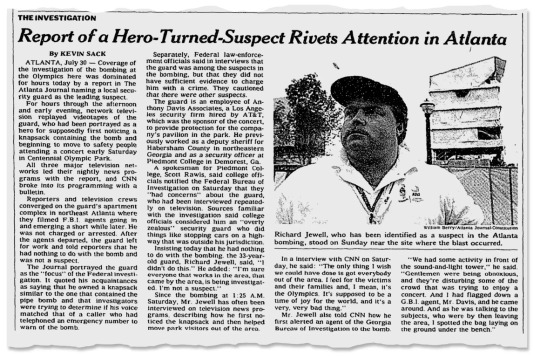
The media, to varying degrees, portrayed Jewell as a failed law enforcement officer who may have planted the bomb so he could "find" it and be a hero.
Jewell’s life was turned upside down – journalists descended on his apartment
A Journal Article quoted acquaintances of Jewell’s, who recalled him owning a backpack similar to the one that held the bomb.
Officials at Piedmont College, a small Georgia school where Jewell had been a security guard, had called the F.B.I. the day of the explosion with concerns that Jewell was “overly zealous.”
If The Times’s reporting showed restraint, focusing more on the local frenzy than the man himself, it was thanks to hard-won lessons in sourcing, Max Frankel wrote in the paper’s magazine. “The Times had learned from its own sad transgressions over the years that whispered accusations against named individuals must not be trusted.”
The pressure began to ease only after Jewell's attorneys hired an ex-FBI agent to administer a polygraph, which Jewell passed.
Jewell was never officially charged, but the FBI thoroughly and publicly searched his home twice, questioned his associates, investigated his background, and maintained 24-hour surveillance of him.
After his exoneration, Jewell filed lawsuits against the media outlets which he said had labelled him, primarily NBC News and The Atlanta Journal-Constitution, and insisted on a formal apology from them.
In July 1997, U.S. Attorney General Janet Reno, prompted by a reporter's question at her weekly news conference, expressed regret over the FBI's leak to the news media that led to the widespread presumption of his guilt, and apologized outright, saying, "I'm very sorry it happened. I think we owe him an apology. I regret the leak.".
October 26th 1996
The investigating US Attorney (Kent Alexander) sent Jewell a letter formally clearing him - "based on the evidence developed to date ... Richard Jewell is not considered a target of the federal criminal investigation into the bombing on July 27, 1996, at Centennial Olympic Park in Atlanta".
July 23rd, 1997
Jewell sued the New York Post for $15 million in damages, contending that the paper portrayed him in articles, photographs and an editorial cartoon as an "aberrant" person with a "bizarre employment history" who was probably guilty of the bombing.
A year after the bombings Kevin Sack wrote “He feels the stares of strangers in restaurants knowing they still wonder if he is the one.”
It had been nine months since the Justice Department cleared Jewell of any involvement. Still, the constant media attention he received at the height of the investigation had turned him into a public figure. Children asked for autographs. A woman he took on a date published a written account of the evening in a city magazine.
“I’m a lot more cynical than I used to be,” Jewell said in Sack’s story. “I’m not as trusting as I once was. And I don’t think I’m as outgoing as I used to be.”
April 13th, 2005
Jewell was exonerated completely when Eric Rudolph, as part of a plea deal, pled guilty to carrying out the bombing attack at the Centennial Olympic Park, as well as three other attacks across southern parts of the US.
2019
Although CNN settled with Jewell for an undisclosed monetary amount, CNN maintained that its coverage had been "fair and accurate".
0 notes